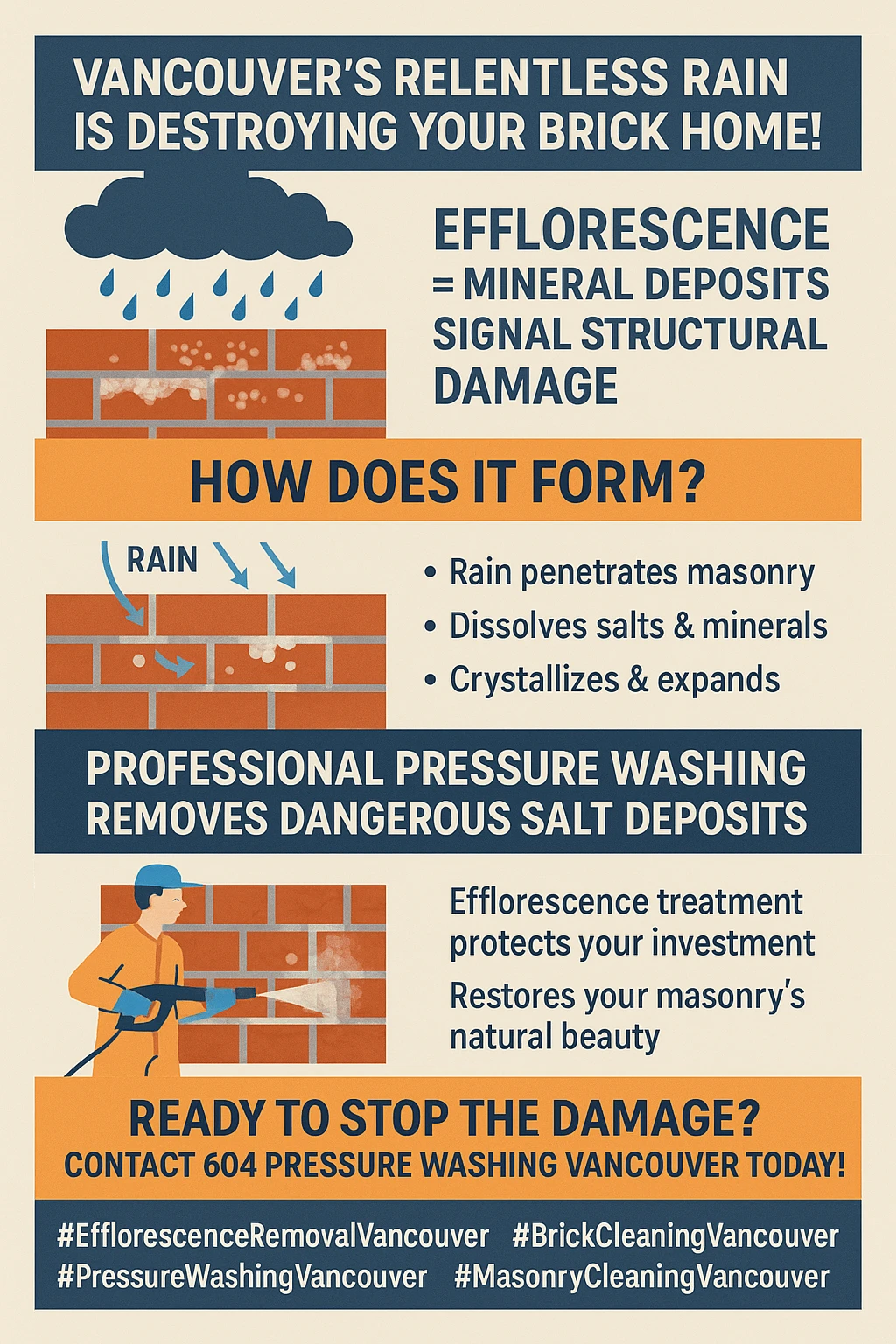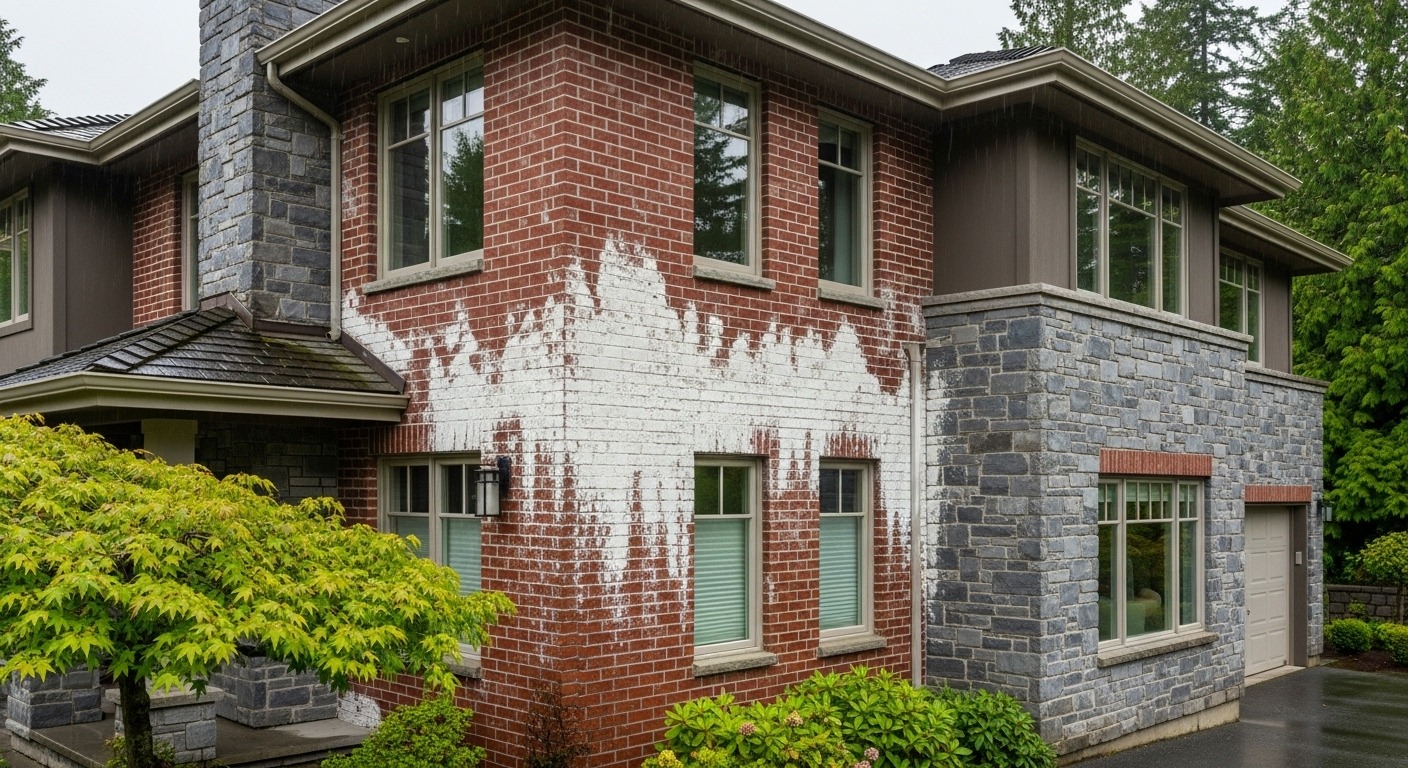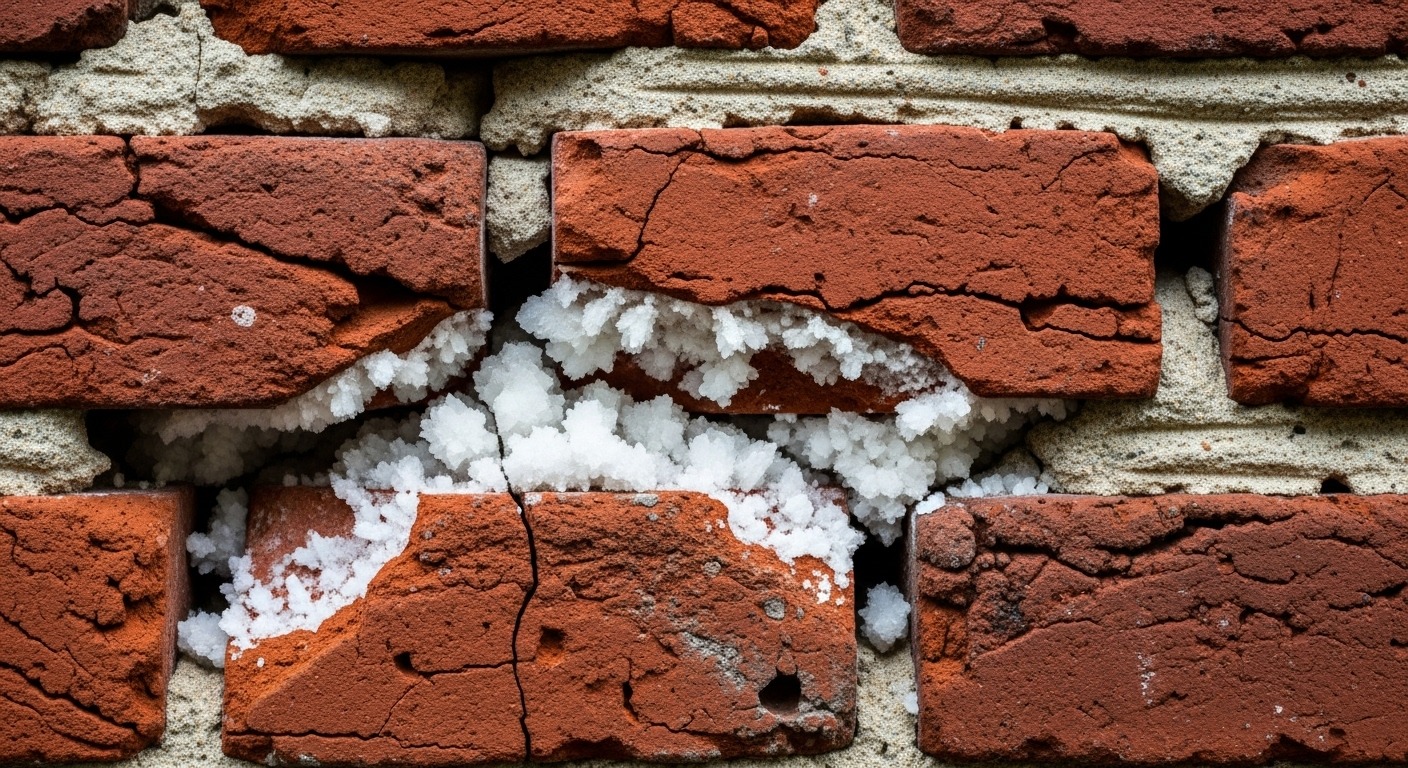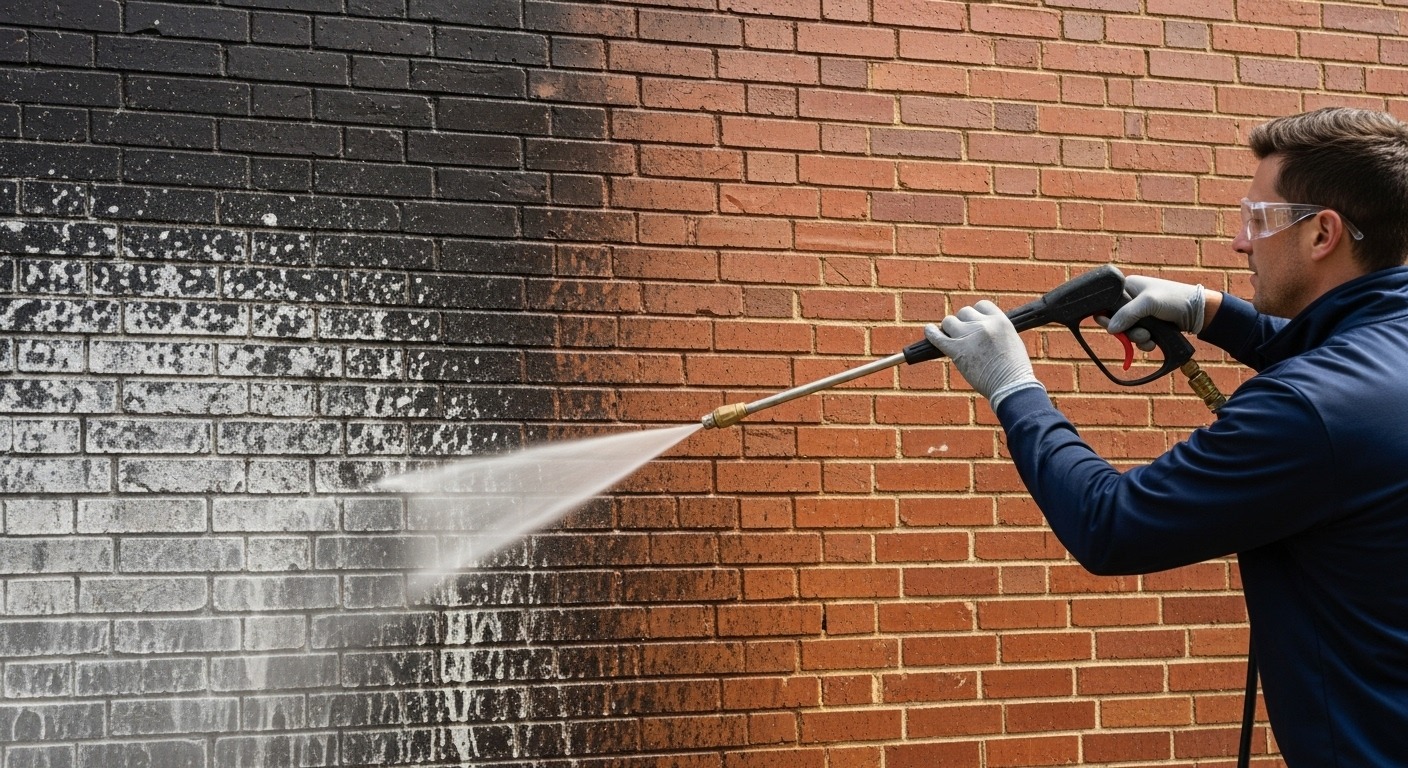Worried about those mysterious white stains spreading across your Vancouver home’s brick and stone surfaces? You’re not alone – Vancouver’s relentless rainfall is creating the perfect conditions for efflorescence, a destructive process that’s quietly compromising masonry structures throughout the city.
If you’ve noticed chalky white deposits appearing on your exterior walls, you’re witnessing more than just an aesthetic problem. Vancouver’s famous rain, which delivers over 1,189mm annually at the airport and up to 2,477mm in North Vancouver, creates ideal conditions for efflorescence formation – a process where water-soluble salts migrate to masonry surfaces and crystallize. This isn’t just about curb appeal; it’s about protecting your property investment from a phenomenon that can cause serious structural damage over time.
The combination of Vancouver’s coastal climate, seasonal weather patterns, and the city’s status as Canada’s third rainiest location with 169 rainy days per year makes efflorescence prevention a critical concern for homeowners. Understanding how this process works and implementing effective treatment strategies can mean the difference between minor maintenance and costly structural repairs. Professional pressure washing services have developed specialized techniques to address these challenges, offering solutions that go far beyond simple surface cleaning.
What makes Vancouver’s situation unique is the cyclical nature of the climate – extremely dry summers followed by months of persistent rainfall create optimal conditions for salt migration and crystallization. This seasonal pattern accelerates efflorescence formation and makes prevention strategies essential rather than optional. The good news is that advanced treatment methods and preventive approaches can effectively protect your property from this moisture-driven damage.
Key Outtakes:
- Efflorescence occurs when Vancouver’s heavy rainfall dissolves salts in masonry materials, carrying them to surfaces where they crystallize into white deposits that can cause structural damage
- Professional pressure washing combined with specialized cleaning agents provides the most effective treatment for removing established efflorescence and preventing future formation
- Prevention strategies including proper drainage, moisture barriers, and regular maintenance prove more cost-effective than reactive repairs in Vancouver’s challenging climate
- Seasonal maintenance schedules aligned with Vancouver’s weather patterns optimize protection and minimize long-term damage to brick and stone surfaces
- Advanced treatment technologies including eco-friendly cleaning solutions and protective coatings offer sustainable approaches to efflorescence management

Understanding Efflorescence Formation in Vancouver’s Climate
Efflorescence represents a complex chemical process that Vancouver’s unique coastal environment makes particularly problematic for masonry structures. The phenomenon occurs when water-soluble salts present in bricks, mortar, and other building materials dissolve in moisture and migrate to surface areas where evaporation leaves behind crystalline deposits. These deposits typically appear as white, sometimes brilliant white, or off-white coloration that can range from light dustings to thick, crusty accumulations that can significantly impact both appearance and structural integrity.
Vancouver’s climate provides all three conditions necessary for efflorescence formation in abundance. The city’s substantial precipitation creates the moisture required to dissolve salts within masonry materials, while the seasonal variations between dry summers and wet winters create optimal conditions for salt migration and subsequent crystallization. The coastal environment adds another dimension to the problem, as salt-laden air can contribute additional soluble materials to the efflorescence formation process.

The timing and severity of efflorescence formation in Vancouver directly correlates with seasonal weather patterns. During the city’s notably dry summer months, masonry materials become thoroughly dehydrated, creating conditions where autumn rainfall triggers aggressive salt dissolution and migration. This cyclical process becomes self-reinforcing, as each wet season creates new opportunities for salt transport to surface areas. The freeze-thaw cycles common in Vancouver’s climate further exacerbate the problem by creating expansion and contraction forces that can drive moisture deeper into masonry systems.
What makes Vancouver’s efflorescence particularly challenging is the persistent nature of the moisture conditions that enable continuous salt migration throughout much of the year. Unlike climates with distinct dry seasons that halt the efflorescence process, Vancouver’s extended periods of high humidity and frequent precipitation create conditions where salt transport continues almost year-round. This persistent moisture environment means that efflorescence formation becomes an ongoing process rather than a seasonal occurrence, requiring comprehensive treatment approaches that address both immediate symptoms and underlying causes.
The Destructive Impact on Brick and Stone Structures
Moving beyond the surface-level aesthetic concerns, efflorescence creates a cascading series of structural problems that can compromise the integrity of masonry systems throughout Vancouver. The process extends far beyond simple white staining to include internal damage mechanisms that can weaken building materials and create expensive repair requirements. Understanding these destructive processes helps homeowners recognize why professional intervention becomes necessary before problems escalate beyond manageable levels.
The most concerning aspect of efflorescence damage occurs when salt crystals form within the bodies of masonry materials rather than simply appearing on surfaces. This internal crystallization process creates expanding pressure that can cause cracking, spalling, and structural distress in brick and stone elements. Vancouver’s climate proves particularly conducive to this internal crystal formation due to the combination of heavy rainfall that saturates materials and the subsequent drying periods that concentrate salts within porous building materials. When crystals grow within confined spaces inside masonry units, the resulting expansion forces can exceed the tensile strength of the material, leading to permanent damage.

The porous nature of many masonry materials used in Vancouver construction significantly influences the severity of efflorescence damage. Dense bricks with low porosity offer limited pathways for salt-laden moisture to reach surface areas, while more porous materials suffer considerably more from efflorescence conditions. The choice of construction materials becomes critical in Vancouver’s high-moisture environment, as materials with higher absorption rates create more opportunities for salt dissolution and transport. This material vulnerability becomes particularly problematic when combined with Vancouver’s persistent rainfall, which continuously replenishes the moisture required for ongoing salt migration.
Moisture penetration pathways multiply the destructive potential of efflorescence by creating vulnerabilities throughout building envelope systems. Common entry points include leaks around windows and doors, cracks in foundation areas, deteriorated mortar joints, and inadequately sealed penetrations through masonry walls. Vancouver’s frequent storms and seasonal weather variations continuously exploit these vulnerabilities, leading to moisture problems that extend far beyond simple surface efflorescence. The coastal winds common in Vancouver can drive moisture into building systems under pressure, accelerating the penetration process and increasing the volume of water available for salt dissolution.
Seasonal damage patterns in Vancouver create particularly insidious problems because masonry deterioration often occurs in areas that receive limited visual inspection. Chimney systems, foundation areas, and other structural elements may develop significant efflorescence damage before problems become apparent to property owners. Water penetration can compromise interior systems, create conditions for mold and mildew formation, and damage building components that require expensive repair or replacement. The combination of Vancouver’s coastal environment and extended wet seasons accelerates these deterioration processes, making early intervention critical for preventing extensive damage.
The long-term implications of untreated efflorescence extend beyond immediate structural concerns to include impacts on property values and insurance considerations. Visible efflorescence signals underlying moisture problems that can raise concerns for potential buyers and may indicate more extensive building envelope issues. Professional property inspectors often identify efflorescence as an indicator of systematic moisture management problems that require comprehensive evaluation and treatment. The recurring nature of efflorescence in Vancouver’s climate means that temporary surface treatments prove inadequate for long-term property protection, necessitating systematic approaches that address root causes.
Professional Pressure Washing Solutions for Efflorescence Removal
The professional pressure washing industry in Vancouver has developed increasingly sophisticated approaches to efflorescence removal that go far beyond simple surface cleaning techniques. These advanced methods recognize that effective treatment requires addressing both visible salt deposits and the underlying conditions that enable their formation. Professional contractors combine mechanical cleaning techniques, specialized chemical treatments, and protective applications to provide comprehensive solutions tailored to Vancouver’s unique climate challenges.

Modern professional cleaning approaches begin with comprehensive surface assessment to determine the specific type of masonry involved, its current condition, and the most appropriate treatment methods. This diagnostic phase proves crucial because different masonry materials require different cleaning approaches, and using inappropriate techniques can potentially cause more damage than the original efflorescence problem. Professional services recognize that pressure washing alone may prove insufficient for persistent efflorescence deposits, particularly those that have penetrated deeply into porous masonry materials over extended periods.
Specialized cleaning agents represent a critical component of professional efflorescence removal that distinguishes these services from simple pressure washing applications. Professional-grade products like concentrated efflorescence removers provide the chemical action necessary to dissolve embedded salt deposits that mechanical cleaning cannot address. These products can be applied at various concentration levels depending on the severity of the efflorescence problem, with mixing ratios that allow for customized treatment intensity. When combined with controlled pressure washing, these specialized cleaners can effectively remove efflorescence without damaging underlying masonry surfaces, a key consideration for preserving the long-term integrity of brick and stone structures.
Following the chemical cleaning and pressure washing phases, professional services often apply penetrating sealers designed to reduce moisture absorption into masonry surfaces. These sealers create a hydrophobic barrier that repels water while allowing the masonry to breathe, a critical function for preventing trapped moisture problems. In Vancouver’s high-precipitation environment, this protective layer becomes an essential component of long-term efflorescence prevention. The application of these advanced sealants requires professional expertise to ensure even coverage and proper bonding with the masonry material, creating a durable barrier against future moisture intrusion.
Prevention Strategies: Protecting Your Investment
While professional efflorescence removal provides an effective solution for existing problems, proactive prevention strategies offer the most cost-effective approach to long-term property protection in Vancouver’s challenging climate. Implementing a comprehensive moisture management plan can significantly reduce the likelihood of efflorescence formation and prevent the associated structural damage. These strategies focus on controlling water intrusion, promoting effective drainage, and maintaining the integrity of the building envelope.

Effective water management begins with ensuring that all drainage systems function correctly and direct water away from foundation areas. This includes regular cleaning of gutters and downspouts, grading soil to slope away from the building, and installing French drains or other subsurface drainage systems where necessary. In Vancouver’s rainy climate, even minor drainage issues can lead to saturated soil conditions that promote moisture wicking into foundation walls and other masonry elements. Regular inspection and maintenance of these systems become a critical first line of defense against efflorescence formation.
Applying water-repellent coatings and sealants represents another key prevention strategy that professional services can implement. These products create a barrier that prevents rainwater from penetrating porous masonry surfaces while still allowing interior moisture to escape. The choice of sealant depends on the specific type of masonry material and its exposure to environmental conditions. For Vancouver homeowners, selecting a high-quality, breathable sealant appropriate for the local climate can provide years of protection against moisture-driven damage. Professional application ensures that these coatings adhere correctly and provide a continuous, effective barrier.
Regular maintenance and inspection of the building envelope can identify and address potential moisture entry points before they become significant problems. This includes checking for and repairing cracked mortar joints, sealing gaps around windows and doors, and ensuring that all flashing is intact and correctly installed. In a city that receives as much precipitation as Vancouver, even small breaches in the building envelope can allow significant amounts of water to enter wall systems, creating ideal conditions for efflorescence. A proactive approach to maintenance proves far more economical than addressing the extensive damage that can result from long-term water intrusion.
DIY vs. Professional Efflorescence Removal
Homeowners in Vancouver often consider a DIY approach to efflorescence removal, but it’s important to understand the potential risks and limitations of this strategy. While simple surface cleaning with a stiff brush and water can sometimes remove light efflorescence deposits, it rarely addresses the underlying causes of the problem. Without a comprehensive approach that includes chemical treatment and preventive sealing, efflorescence is likely to return, particularly given Vancouver’s persistent rainfall.
The primary risk associated with DIY efflorescence removal is the potential for damaging masonry surfaces. Using the wrong cleaning agents, such as overly acidic solutions, can etch or discolor brick and stone. Similarly, improper use of a pressure washer can erode mortar joints and cause spalling on softer masonry materials. Professional services have the training and experience to select the appropriate cleaning methods and pressure settings for different types of surfaces, minimizing the risk of damage while achieving effective results.
Furthermore, DIY methods often fail to completely remove embedded salt deposits, leading to a rapid recurrence of the problem. Professional-grade cleaning agents and techniques are designed to penetrate porous materials and dissolve salts that have migrated deep into the masonry. Without access to these specialized products and equipment, homeowners may find themselves repeating the cleaning process frequently, with diminishing results over time. This cycle of incomplete cleaning can allow subsurface crystallization to continue, potentially leading to long-term structural issues.
Ultimately, the decision between DIY and professional efflorescence removal in Vancouver comes down to a trade-off between short-term cost savings and long-term effectiveness. While a professional service represents a greater initial investment, it provides a more comprehensive and durable solution that addresses both the symptoms and the root causes of efflorescence. For homeowners looking to protect their property investment in Vancouver’s challenging climate, professional removal and prevention services offer a level of expertise and assurance that DIY methods simply cannot match.
Frequently Asked Questions (FAQs)
What is the white stuff on my bricks?
The white, chalky substance you see on your bricks is called efflorescence. It’s a crystalline deposit of water-soluble salts that are left behind when water evaporates from the masonry surface. It’s particularly common in rainy climates like Vancouver.
Is efflorescence harmful to my home?
While it may seem like a cosmetic issue, efflorescence is a sign of moisture moving through your masonry. If the salt crystals form within the brick or stone (a process called cryptoflorescence), it can create internal pressure, leading to spalling, cracking, and long-term structural damage.
Can I just wash efflorescence off myself?
You can often remove light efflorescence with a stiff brush and water. However, this doesn’t address the underlying moisture problem, and the deposits will likely return. For persistent cases, professional cleaning with specialized agents is needed to dissolve the salts and prevent damage from improper pressure washing.
How do professionals remove efflorescence?
Professionals use a multi-step process. They start with a low-pressure wash, apply specialized, environmentally-safe cleaning agents to dissolve the salt deposits, and then rinse thoroughly. They often finish by applying a breathable, water-repellent sealant to prevent future moisture intrusion.
How can I prevent efflorescence from coming back?
The key is moisture control. Ensure your gutters and downspouts are clear and directing water away from your foundation. Seal any cracks in your masonry or mortar joints. A professionally applied breathable sealant is one of the most effective ways to prevent water from penetrating your brick and stone surfaces, which is crucial in Vancouver’s wet climate.
Wrapping Up: Protecting Your Vancouver Property
Efflorescence is more than just an unsightly nuisance for Vancouver homeowners; it’s a clear warning sign of moisture-related issues that can lead to significant structural damage over time. In a city defined by its persistent rainfall and coastal climate, taking a proactive stance against this common problem is essential for protecting your property’s value and integrity. Understanding that the white stains on your brick and stone are symptoms of a deeper issue is the first step toward an effective solution.
While DIY methods may offer a temporary fix, the recurring nature of efflorescence in our region calls for a more robust, professional approach. Specialized cleaning agents, proper pressure washing techniques, and the application of advanced preventative sealants are key components of a long-term strategy. By addressing both the visible salt deposits and the underlying moisture pathways, you can halt the destructive cycle of salt crystallization before it compromises your home’s masonry.
Investing in professional efflorescence removal and prevention is an investment in the longevity of your property. By partnering with experts who understand the unique challenges of Vancouver’s climate, you can ensure your home not only looks its best but is also shielded from the damaging effects of moisture intrusion. Don’t wait for minor stains to become major structural problems—take action to protect your home today.

